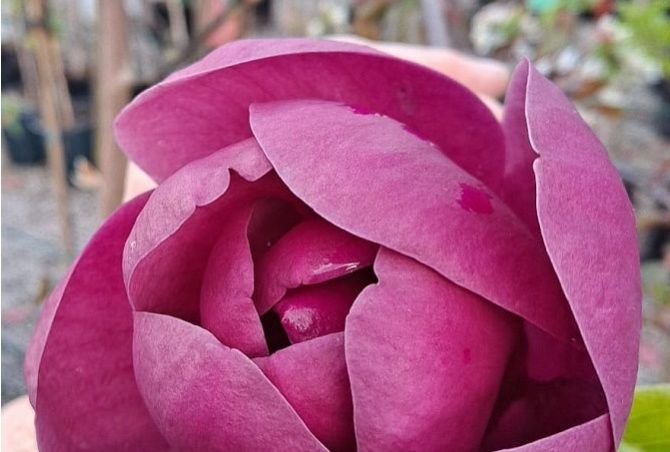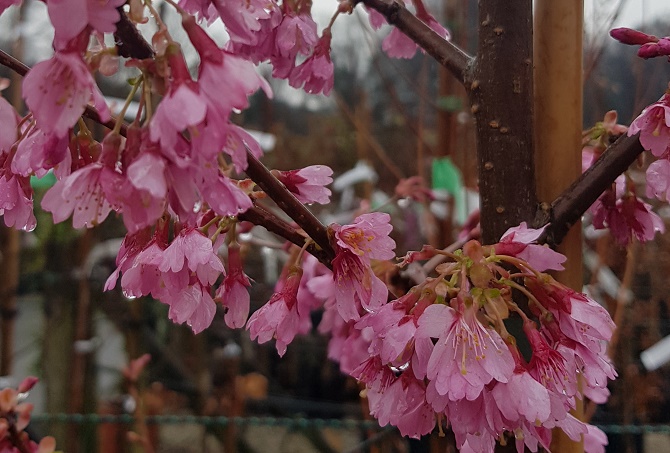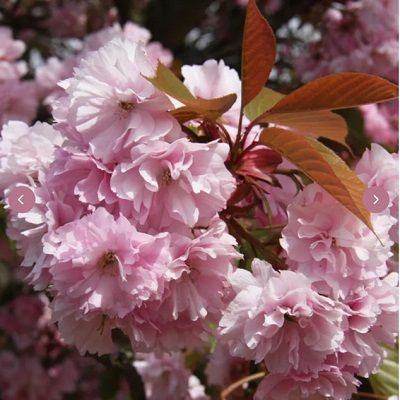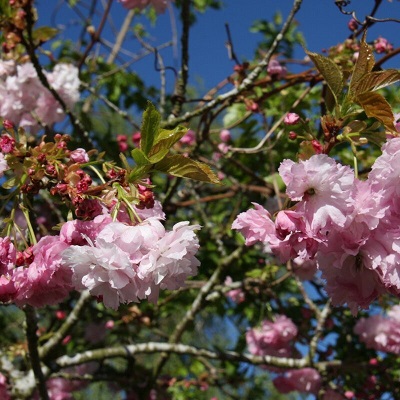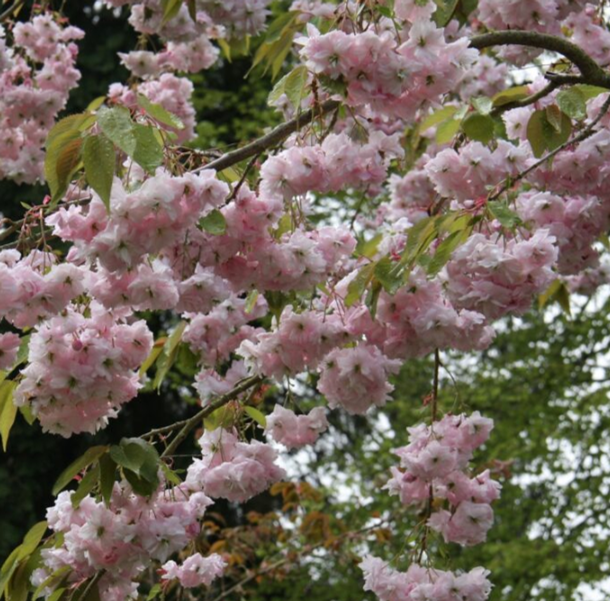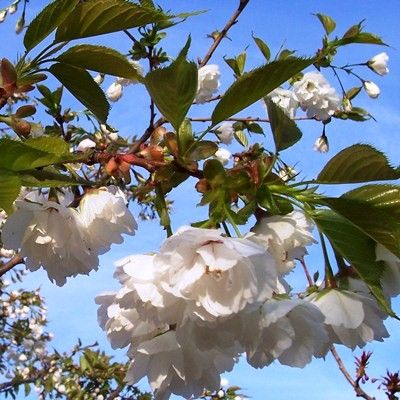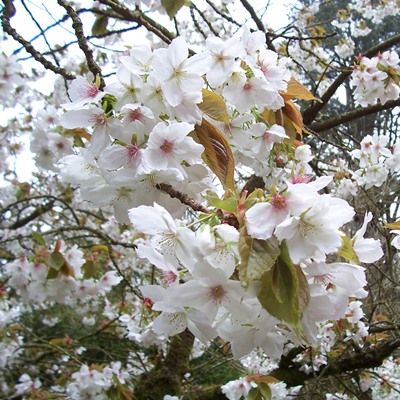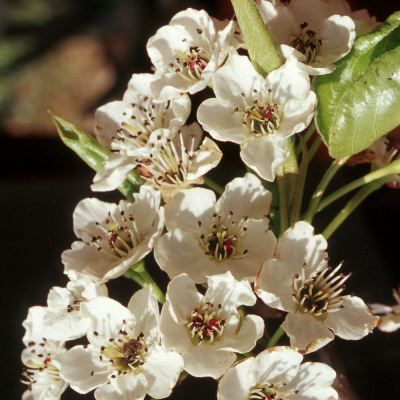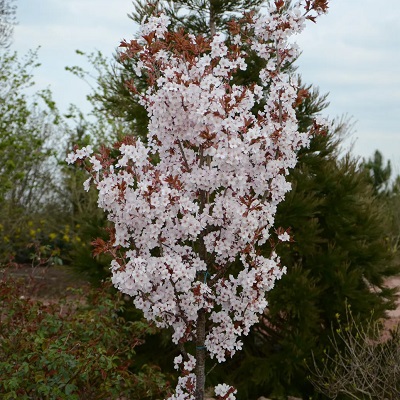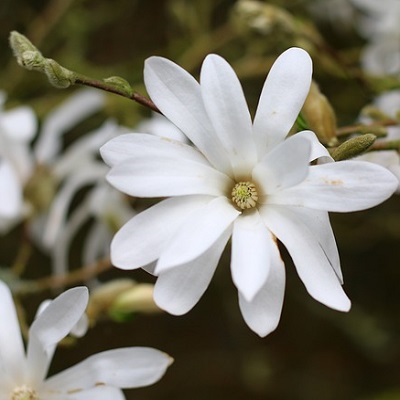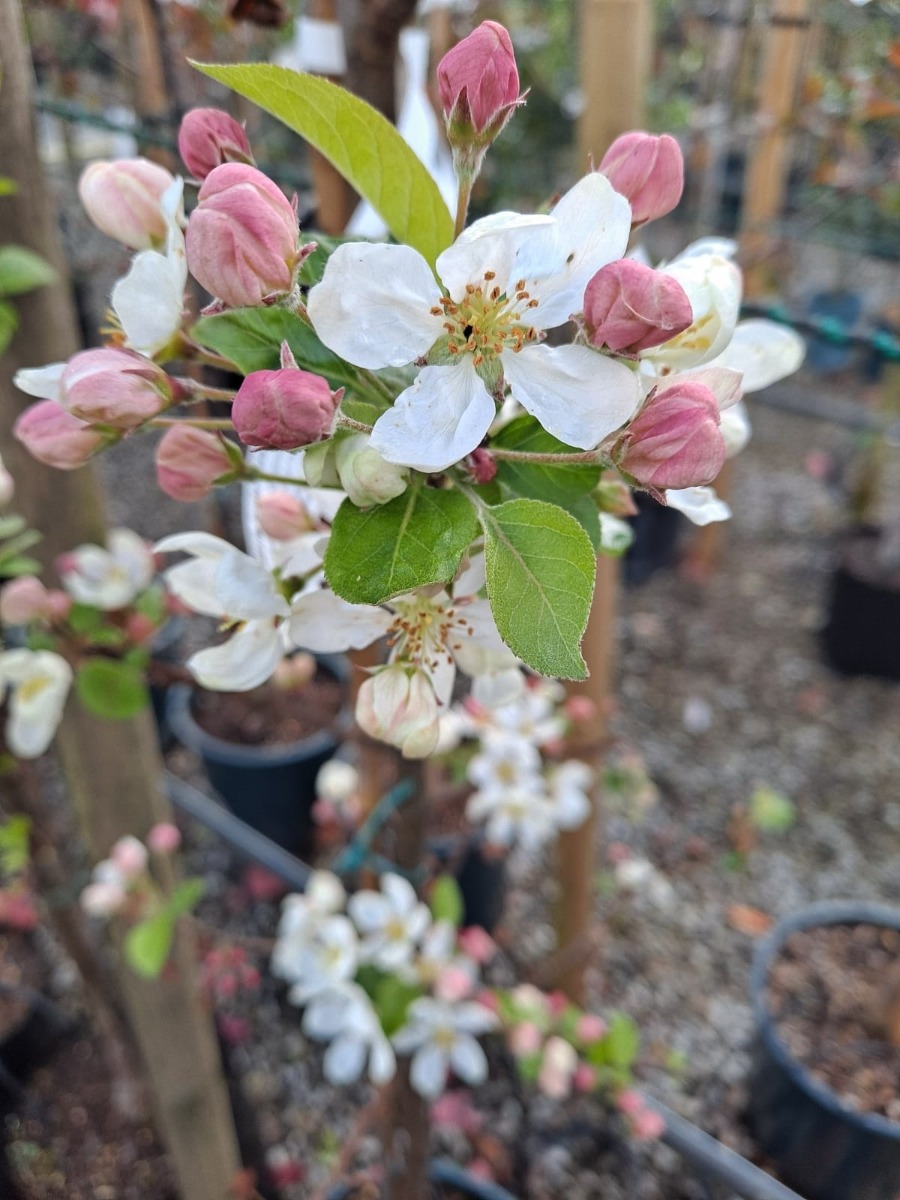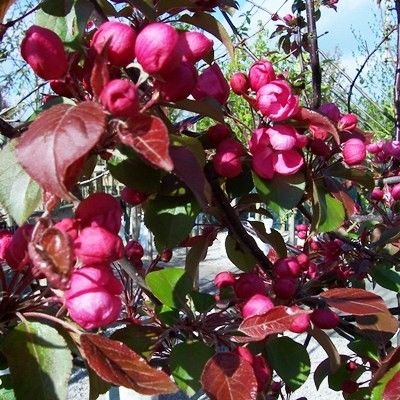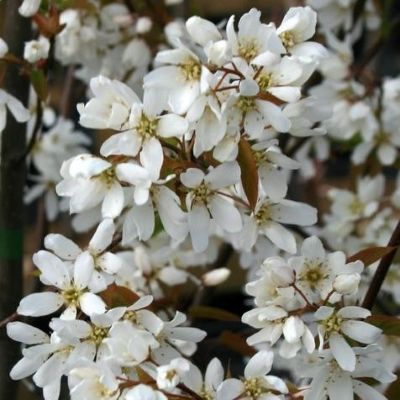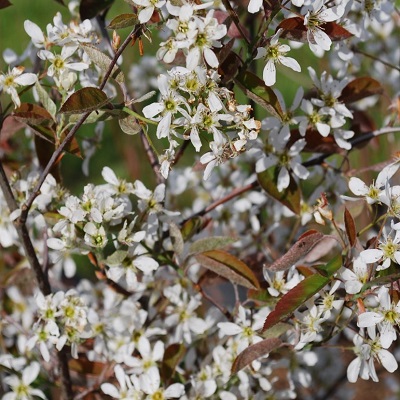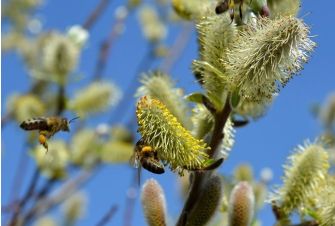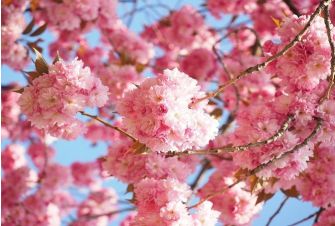It might not feel like it, due to the weather conditions on some days, but spring has sprung! Our trees and shrubs here at English Woodlands nursery in East Sussex know it's time to amaze us all with their beautiful blossom and spring growth. Everywhere we look there are buds, flowers, and fresh new shoots in the most vibrant of colours. One of the joys of the spring season is the fact that every species and cultivar follows a slightly different agenda, meaning that they excel in various ways and at different times. This enables the entire garden to deliver continuous joy in the form of successional flowering and ongoing seasonal interest. Some early blossom is already fading, but these early blooms are so valuable, not only for lifting the spirits after winter, but also for bees and other beneficial garden insects.
One of the first ornamental cherry trees to brighten up the gloom with its strong, pink, early blossom is Prunus 'Okame'. This small tree (mature height: up to 7m) was created by the famous Captain Collingwood Ingram during the 1940s and it has stood the test of time, gaining the coveted RHS Award of Garden Merit in 2002. Not only does it have a neat shape and impressive early blossom but it also goes out in a fanfare of autumn colour later in the year.
Another delightful tiny tree is the weeping form of Prunus 'Snow Showers', which bears delicate white flowers early in spring, even if there is a shower of snow! The simple, open blooms are easy to access by buzzing bees, providing a vital supply of nectar and pollen.
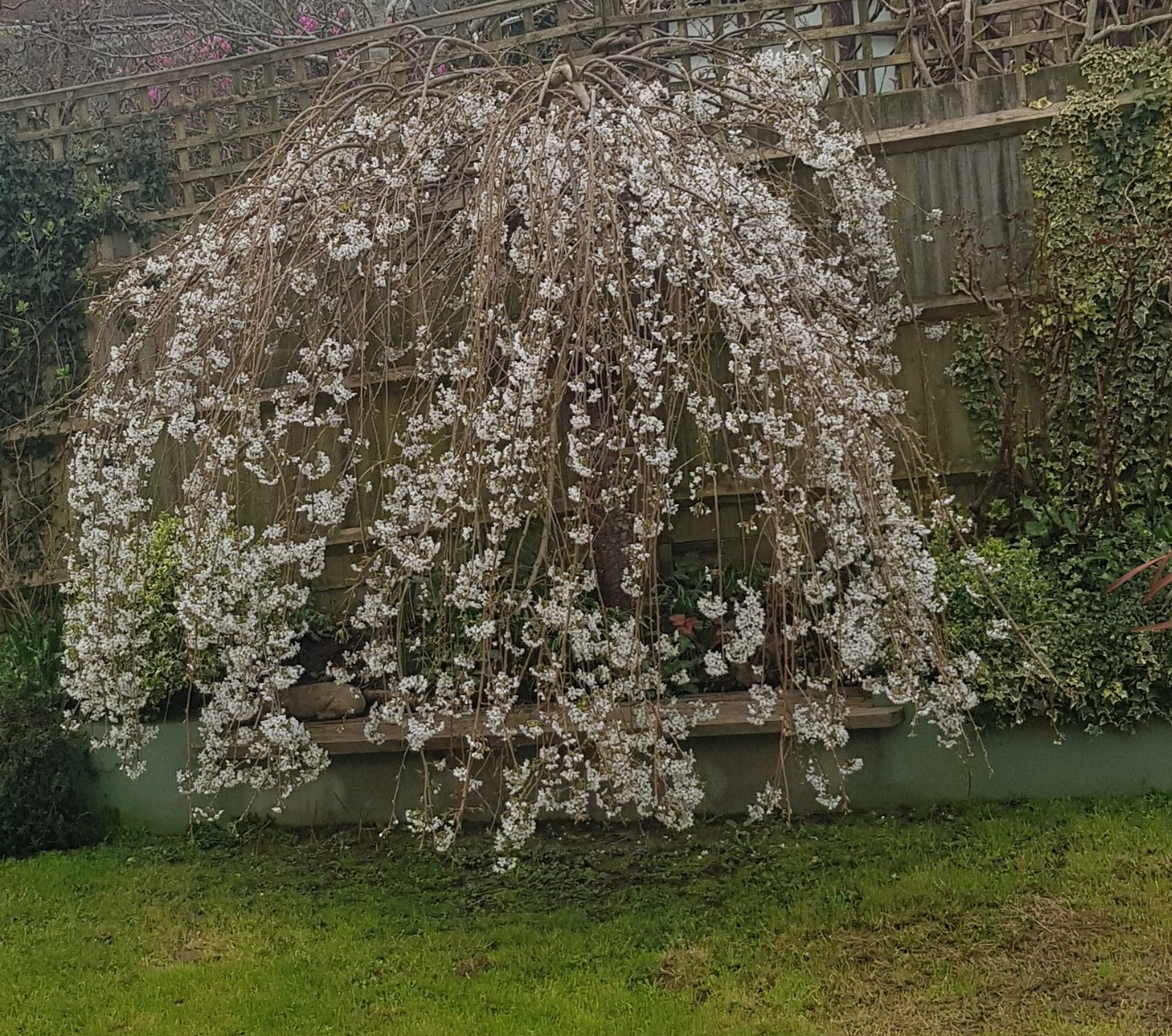
We would love for you to drop into the nursery at Cross in Hand, East Sussex, in order to witness the spectacle in person! This is the very best time of year to be able to compare spring-flowering trees and shrubs so that you can select your favourites. If you're not sure what will suit your garden or plot, we always love to offer advice. It's important to consider the type of soil, the microclimate, location and space available.
Let's give you some examples of some of the favourites: the blousy, double pink blossom of Prunus 'Kanzan' appears in April, being one of the showiest and perhaps one of the best-known varieties of flowering cherries. It has glowing, deep pink flowers which look like fluffy candyfloss! The spring foliage is coppery red, turning green and then orange in autumn. P. 'Kanzan' was named after a Chinese mountain and deservedly received the Royal Horticultural Society's Award of Garden Merit in 2002. A medium-sized tree, when mature, It can be expected to grow up to 8m tall and in tune with most cherries, likes a sunny spot in free-draining soil.
Prunus 'Pink Perfection' is another popular beauty (below) that produces delightful clusters of frilly, double blooms in pretty pink. These appear slightly later in spring, usually during May. It's a small, spreading flowering cherry tree which is a great one for smaller spaces, and another deserved recipient of the RHS Award of Garden Merit.
Some cherries are compact enough for a large pot, including the diminuitive Prunus 'Kiku-shidare-zakura', which is also known as Cheals weeping cherry. It is one of the smallest weeping cherries, (below) but still manages to produce a stunning display of deep-pink, double flowers which can measure up to 4cm across. The pendulous, weeping branches make a charming feature, particularly when placed at eye height so that the blossom can cascade down to the ground.
If white blossom is your favourite, you are not alone, and there are some stunning trees to charm the senses. Take the double-flowered wild cherry, Prunus avium 'Plena', for example (below). It's another RHS Award of Garden Merit tree, loved especially for its resilient nature and stunning spring blossom show. The flowers form a dramatic picture in late April and early May when it is smothered in a fluffy white floral cloud. The blooms hang in wonderful clusters from the branches. Give it space to grow, as this tree can reach a height of 12 metres and a spread of 8 metres when mature.
Prunus 'Tai-Haku' is known as the Great White Cherry (below), and considered to be one of the best pure white cherries, with clusters of mainly single, large white flowers which look stunning during April, against the very young, bronze foliage. This is a very special tree indeed, as it was believed to be exinct in its native homeland of Japan. However, a single tree was discovered in Sussex, which has allowed this tree to return! Its dazzling white flowers give it the common name of Great White, as the tree itself is medium-sized, growing up to 7 metres tall x around 5 metres wide. A great choice, suitable for urban settings as well as for avenue planting or as a specimen.
There's a lot to be said for trees that adopt an upright shape, and one of the most popular is the architecturally-pleasing Pyrus chanticleer, the ornamental Callery pear (below). This useful and attractive tree is one of the first to reveal its fresh, green leaves early in the spring, and the charming single flowers appear just before the leaves. Because it keeps its leaves until late autumn, this makes a great screening tree. It's a really good all-rounder, with early flowers for bees and something for all seasons.
Prunus 'Spire' also adopts an upright shape (below), making it suitable for a smaller or medium-sized garden. The branches fan out slightly as they mature, and the tree eventually forms a vase shape. The April blossom is very pale pink, being single flowers which gently fade to white. Not only is this a beautiful tree, but it's a great one for pollinating insects as the flowers are easily accessible.
It's not only flowering cherries and pears that provide amazing blooms in spring. Magnolias are also stars of the season, with M. stellata, the star magnolia, displaying this feature in a literal sense, in a show that never fails to delight. The white, early spring flowers look like stars and they cover this large shrub in a dazzling cloak of spring sparkle.
There are many different forms of Magnolias, but they have one thing in common: these are definitely not shrinking violets! They display their flowers boldly, for all to admire. Some have white flowers, others have pink, and the one shown below looks rather like a deep pink tulip, hence the name: Magnolia 'Black Tulip'.
Crab apples belong to the Malus family and their blossom is beautiful, appearing throughout April and May. There are dozens of different varieties, some with pure white flowers, others with pink, through to deep red and purple. What's more, this versatile tree produces edible fruit that can stay on the tree for most of the winter, unless you want to harvest it for crab apple jelly. These trees are easy to please because they can tolerate heavier soils and cooler conditions than flowering cherries. Their roots also tend to be deeper, so they rarely show on the surface. Crab apples provide interest through many different seasons and offer a feast for the birds when they most need it. Pictured below is Malus 'Evereste', which has the RHS Award of Garden Merit. It produces unusually large white flowers in April, opening from scarlet flower buds that fade to pink. Then attractive crab apples develop in late summer, flushed with shades of yellow, orange and red.
Complementing M. 'Evereste' superbly, is Malus 'Rudolph', (pictured below) which is a red one! This wonderful small tree produces rose-pink flowers in late spring, then the foliage is copper-red during spring and summer, gradually turning bronze-green. The red fruits emerge in autumn, contrasting against the autumn yellow leaves. A good choice, particularly because this tree is resistant to most pests and diseases.
There is no natural end to the delights in store for all of us this spring, but we should never neglect to mention that delightful small tree or large shrub, Amelanchier. It is a plant for all seasons, with starry spring flowers, small fruit later in the season and spectacular autumn colour. It is a people's favourite and not without good reason, as you can see below! Also known as a Juneberry, or snowy mespilus, it earns its place in any garden, including within small spaces. Amelanchiers can tolerate pruning and shaping and an added attraction is the fact that the berries are edible for humans as well as birds.

